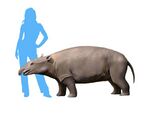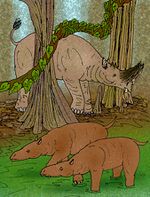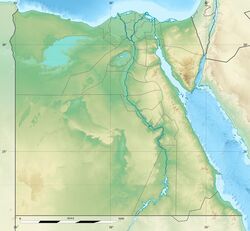Earth:Qasr el Sagha Formation
| Quasr el Sagha Formation Stratigraphic range: Priabonian ~37–34 Ma | |
|---|---|
| Type | Geological formation |
| Sub-units | Dir Abu Lifa & Temple Members |
| Underlies | Gebel Qatrani Formation |
| Overlies | Birket Qarun Formation |
| Lithology | |
| Primary | Sandstone |
| Other | Mudstone |
| Location | |
| Location | Fayum District |
| Coordinates | [ ⚑ ] : 29°30′N 30°30′E / 29.5°N 30.5°E |
| Paleocoordinates | [ ⚑ ] 24°54′N 26°30′E / 24.9°N 26.5°E |
| Country | |
| Extent | Wadi El Hitan |
The Qasr el Sagha Formation is a geological formation located in Egypt.[1] The formation is part of the Wadi El Hitan World Heritage Site. The Qasr el Sagha Formation overlies the Birket Qarun Formation and is overlain by the Gebel Qatrani Formation. The sandstones and shales of the formation were deposited in a deltaic to shallow marine environment.[2] It dates to the Late Eocene (middle Priabonian, 37.2 to 33.9 million years ago).[3]
Paleontological significance
Fossils of the early whale genus Saghacetus ("Sagha whale", originally named "Zeuglodon osiris") were first collected at Qasr al Sagha by German explorer Georg August Schweinfurth in January 1886 (a well-preserved dentary).Saghacetus is common in the middle of Qasr el Sagha, but there are few other specimens of archaeocetes whales; the only exception being the enigmatic "Prozeuglodon stromeri", named in 1828 based on specimens from 1904, but never adequately described before their destruction during the bombing of Munich in World War II.[4]
Other fossils found in the formation include:[5]
Afrotheres
| Afrotheres | ||||||
|---|---|---|---|---|---|---|
| Genus | Species | Presence | Stratigraphic member | Material | Notes | Images |
| Archaeosiren | A. stromeri | Westlich von Dimeh, Fayum.[6] | A skull & isolated thoracic vertebrae.[6] | Synonym of Eosiren libyca. | ||
| Barytherium | B. cf. B. grave | Locality 25 & an unspecified locality.[7] | Dir Abu Lifa Member.[7] | 2 teeth (DPC 2917 & 4071).[7] | A basal proboscidean. |  |
| Eosiren | E. libyca | North of Birket Qarun.[6] | Temple Member.[6] | Skulls & vertebrae.[6] | A dugongid. |  |
| Moeritherium | M. lyonsi | Various localities.[7] | Dir Abu Lifa Member.[7] | Numerous specimens.[7] | A basal proboscidean. |  |
| Pliohyracidae | Genus & species indeterminate | ½ mile east of Qasr el Sagha Temple.[7] | Dir Abu Lifa Member.[7] | A mandible (AMNH 13445).[7] | A large hyrax formerly thought to be a juvenile specimen of Moeritherium gracile.[7] | |
| Protosiren | P. sp. | Mandible.[6] | Actually from the Gehannam Formation or Birket Qarun Formation. | |||
Ferae
| Ferae | ||||||
|---|---|---|---|---|---|---|
| Genus | Species | Presence | Stratigraphic member | Material | Notes | Images |
| Apterodon | A. saghensis | Locality 25.[7] | Dir Abu Lifa Member.[7] | Left mandibular fragment.[7] | A hyaenodont. | |
| A. sp. | Three localities.[7] | Dir Abu Lifa & Temple member.[7] | Mandibular elements & 2 humeri.[7] | A hyaenodont. | ||
| cf. Hyaenodon | cf. H. brachycephalus | "Near Qasr el Sagha".[7] | An eroded left mandibular corpus (AMNH 128553).[7] | A hyaenodont. | ||
Ungulates
| Ungulates | ||||||
|---|---|---|---|---|---|---|
| Genus | Species | Presence | Stratigraphic member | Material | Notes | Images |
| cf. Bothriogenys | cf. B. sp. | Locality 25.[7] | Dir Abu Lifa Member.[7] | A weathered right distal humerus & shaft.[7] | An anthracothere. |  |
| Dorudon | D. atrox | "Feinktirnigem graugriinlichem Sandstein der Saghastufe, Fayum".[6] | Remains of an immature individual now destroyed.[6] | A basilosaurid whale. |  | |
| Prozeuglodon | P. stromeri | "Feinktirnigem graugriinlichem Sandstein der Saghastufe, Fayum".[6] | Remains of an immature individual now destroyed.[6] | Junior synonym of Dorudon atrox. | ||
| Saghacetus | S. osiris | Multiple localities.[6] | Temple Member.[6] | Multiple specimens.[6][8] | A basilosaurid whale. |  |
| Stromerius | S. nidensis | Blanckenhorn’s interval II 5a of the Saghastufe.[9] | Temple Member.[9] | 2 vertebral sequences (UM 100140 & BSPM 1902.XI.504-510).[9] | A basilosaurid whale. |  |
| Zeuglodon | Z. elliotsmithii | North of Birket Qarun.[6] | An endocast.[6] | Junior synonym of Saghacetus osiris. | ||
| Z. sensitivus | Gar-el-Gehannem.[6] | Temple Member.[6] | An endocast.[6] | Junior synonym of Saghacetus osiris. | ||
| Z. zitteli | "Zeuglodonberg".[6] | A fragmentary rostrum & 3 articulated cervical vertebrae.[6] | Junior synonym of Saghacetus osiris. | |||
Squamates
| Squmates | ||||||
|---|---|---|---|---|---|---|
| Genus | Species | Presence | Stratigraphic member | Material | Notes | Images |
| Gigantophis | G. garstini | "An unspecified locality north of Birket Qarun, Fayum".[10] | Vertebrae & ribs.[10] | A madtsoiid snake. | ||
Testudines
| Testudines | ||||||
|---|---|---|---|---|---|---|
| Genus | Species | Presence | Stratigraphic member | Material | Notes | Images |
| Andrewsemys | A. libyca | An almost complete & well-preserved shell.[11] | A podocnemidid. | |||
| Cordichelys | C. sp. | North of Birket Qarun.[12] | A nearly complete cranium lacking only the premaxillae (UMMP 13994).[12] | A podocnemidid. | ||
| Stereogenys | 'S.' libyca | An almost complete & well-preserved shell.[11] | Reassigned to Andrewsemys. | |||
| S.(?) sp. | North of Birket Qarun.[12] | A mostly-complete carapace & plastron (CGM 8718).[12] | A podocnemidid. | |||
- Misrichthys stromeri
- Carcharhinus aff. frequens
- Odontorhytis aff. pappenheimi
- ?Jacquhermania attiai
- Carcharhinus sp.
- Coupatezia sp.
- Ouledia sp.
- Pastinachus sp.
- Rhinobatos sp.
- Scyliorhinus sp.
- ?Sphyrna sp.
- Pristidae indet.
- "Cretolamna" twiggsensis
See also
References
- ↑ Vickers-Rich & Rich 1993
- ↑ Gingerich et al., 2019
- ↑ Tamariskenbucht (Eocene of Egypt) in the Paleobiology Database. Retrieved July 2013.
- ↑ Gingerich 2007, pp. 363–4
- ↑ Qasr el Sagha Formation at Fossilworks.org
- ↑ 6.00 6.01 6.02 6.03 6.04 6.05 6.06 6.07 6.08 6.09 6.10 6.11 6.12 6.13 6.14 6.15 6.16 6.17 6.18 6.19 Gingerich, Philip D (September 2006). "Marine Mammals (Cetacean and Sirenia) from the Eocene of Gebel Mokattam and Fayum, Egypt: Stratigraphy, Age, and Paleoenvironments.". University of Michigan Papers on Paleontology 30: 1–84. https://www.researchgate.net/publication/30849389.
- ↑ 7.00 7.01 7.02 7.03 7.04 7.05 7.06 7.07 7.08 7.09 7.10 7.11 7.12 7.13 7.14 7.15 7.16 7.17 7.18 7.19 7.20 Holroyd, P.; Simons, E.; Bown, T.; Polly, P. D.; Kraus, M. (1996) (in en). New records of terrestrial mammals from the Upper Eocene Qasr El Sagha Formation, Fayum Depression, Egypt. https://www.researchgate.net/publication/230554238.
- ↑ Gingerich, Philip D.. "Early Evolution of Whales A Century of Research in Egypt". Elwyn Simons: A Search for Origins. https://www.researchgate.net/publication/253535544.
- ↑ 9.0 9.1 9.2 Gingerich, Philip. Stromerius Nidensis, New Archaeocete (Mammalia, Cetacea) From the Upper Eocene Qasr El-Sagha Formation, Fayum, Egypt. https://www.academia.edu/21636009.
- ↑ 10.0 10.1 Rio, Jonathan P.; Mannion, Philip D. (2017-07-04). "The osteology of the giant snake Gigantophis garstini from the upper Eocene of North Africa and its bearing on the phylogenetic relationships and biogeography of Madtsoiidae". Journal of Vertebrate Paleontology 37 (4): e1347179. doi:10.1080/02724634.2017.1347179. ISSN 0272-4634.
- ↑ 11.0 11.1 Pérez-García, Adán (2019-03-16). "New information and establishment of a new genus for the Egyptian Paleogene turtle 'Stereogenys' libyca (Podocnemididae, Erymnochelyinae)". Historical Biology 31 (3): 383–392. doi:10.1080/08912963.2017.1374383. ISSN 0891-2963. https://doi.org/10.1080/08912963.2017.1374383.
- ↑ 12.0 12.1 12.2 12.3 Cherney, Michael D.; Mantilla, J. a. W.; Gingerich, P.; Zalmout, Iyad S.; Antar, M. (2020) (in en). New Specimens of the Late Eocene Turtle Cordichelys (Pleurodira: Podocnemididae) From Wadi Al Hitan and Qasr El-Sagha in the Fayum Province of Eqypt.
Bibliography
- Gingerich, Philip D.; Mohammed Sameh M. Antar, and Iyad S. Zalmout. 2019. Aegicetus gehennae, a new late Eocene protocetid (Cetacea, Archaeoceti) from Wadi Al Hitan, Egypt, and the transition to tail-powered swimming in whales. PLoS ONE 14. e0225391. doi:10.1371/journal.pone.0225391 PMID 31825956 PMC 6905522
- A. Pérez-García. 2019. New information and establishment of a new genus for the Egyptian Paleogene turtle ‘Stereogenys’ libyca (Podocnemididae, Erymnochelyinae). Historical Biology 31(3):383-392
- S. Adnet, H. Cappetta, S. Elnahas and A. Strougo. 2011. A new Priabonian Chondrichthyans assemblage from the Western desert, Egypt: Correlation with the Fayum oasis. Journal of African Earth Sciences 61:27-37
- Gingerich, Philip D (2007). "Stromerius nidensis, new archaeocete (Mammalia, Cetacea) from the Upper Eocene Qasr El-Sagha Formation, Fayum, Egypt". Contributions from the Museum of Paleontology 31 (13): 363–78. OCLC 214233870. http://deepblue.lib.umich.edu/bitstream/2027.42/57499/1/Vol%2031%20No%2013%20final%2012-19-07.pdf.
- Vickers-Rich, Patricia; Rich, Thomas Hewitt V. (1993). Wildlife of Gondwana. Indiana University Press. ISBN 0-7301-0315-3.
 |


